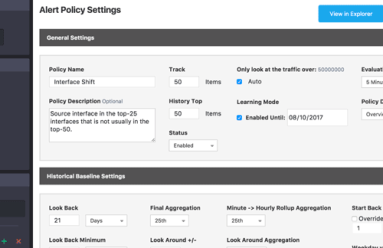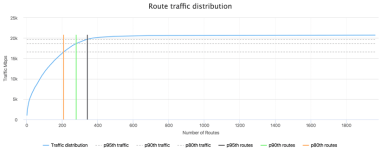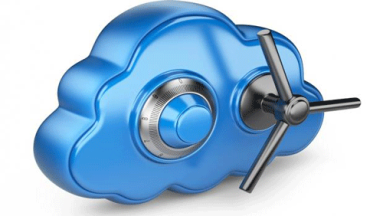Kentik Blog
























Docker’s $1.3 billion valuation. Disney $1.6 billion acquisition for streaming services. And international internet speed tests and U.S. home internet data caps. Those stories and more after the jump.
Major cyber-security incidents keep on coming, the latest being the theft from HBO of 1.5 terabytes of private data. We often frame Kentik Detect’s advanced anomaly detection and alerting system in terms of defense against DDoS attacks, but large-scale transfer of data from private servers to unfamiliar destinations also creates anomalous traffic. In this post we look at several ways to configure our alerting system to see breaches like the attack on HBO.
With BGP and NetFlow correlated into a unified datastore, Kentik Detect’s advanced analytics provide valuable insights for both engineering and sales. In this post we look into a fairly recent addition to Kentik Detect, Route Traffic Analytics. Especially useful for capacity planners and peering coordinators, RTA makes it easy to see how many unique routes are represented in a given percent of your traffic, which indicates the route capacity needed in your edge routers.
DDoS attacks for all: Netflix tests against these disruptive attacks. Analyst firm Frost & Sullivan talks about how service providers need better DDoS mitigation. New Kaspersky Lab research recognized a Chinese telecom as seeing the biggest DDoS attack in Q2. More after the jump…
Can BGP routing tables provide actionable insights for both engineering and sales? Kentik Detect correlates BGP with flow records like NetFlow to deliver advanced analytics that unlock valuable knowledge hiding in your routes. In this post, we look at our Peering Analytics feature, which lets you see whether your traffic is taking the most cost-effective and performant routes to get where it’s going, including who you should be peering with to reduce transit costs.
This week, Verizon was dubbed a winner of network speeds. Mitel agreed to buy ShoreTel. Viacom said it wouldn’t buy Scripps. Packet grew globally. The Ericsson-Cisco partnership slowed. And feature articles highlighted Cuba’s internet and IT automation costs. More headlines after the jump…
Among Kentik Detect’s unique features is the fact that it’s a high-performance network visibility solution that’s available as a SaaS. Naturally, data security in the cloud can be an initial concern for many customers, but most end up opting for SaaS deployment. In this post we look at some of the top factors to consider in making that decision, and why most customers conclude that there’s no risk to taking advantage of Kentik Detect as a SaaS.
Google announced a new algorithm for higher bandwidths and lower latencies. NASA gave advice on IoT networks. Python is the most popular programming language. And Dow Jones is the latest to see an S3 misconfiguration.
What do summer blockbusters have to do with network operations? As utilization explodes and legacy tools stagnate, keeping a network secure and performant can feel like a struggle against evil forces. In this post we look at network operations as a hero’s journey, complete with the traditional three acts that shape most gripping tales. Can networks be rescued from the dangers and drudgery of archaic tools? Bring popcorn…
We’re very excited to share that KDDI, one of the world’s largest telecommunications companies, has selected the Kentik platform for network planning, operations, and to protect their key network assets and services. Read about the reasons that KDDI chose Kentik and why we’re so excited about this announcement.









